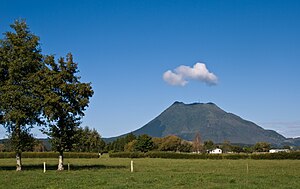Mount Edgecumbe (New Zealand)
|
Mount Edgecumbe Māori: Pūtauaki |
||
|---|---|---|
|
Mount Edgecumbe ( Pūtauaki ) as seen from the north |
||
| height | 820 m | |
| location | Bay of Plenty , New Zealand | |
| Coordinates | 38 ° 6 '22 " S , 176 ° 44' 10" O | |
|
|
||
| Type | Stratovolcano | |
| Age of the rock | 4000 years | |
| Last eruption | around 900 AD | |
The Mount Edgecumbe , in the language of the Māori Pūtauaki called, is a currently dormant volcano in the Taupo Volcanic Zone in the region Bay of Plenty on the North Island of New Zealand .
Origin of name
The name Mount Edgecumbe was given to the mountain from the British navigator and explorer Captain James Cook , who visited the Bay of Plenty in October 1769 and saw the imposing elevation from the sea. He may have named the mountain after George Edgcumbe , an admiral in the British Navy.
For Putauaki there are many different legends in the mythology of the Maori , but none of them explained the origin of his name.
geography
The 820 m high volcanic cone is located 46 km east of Rotorua and 28 km southwest of Whakatāne on the southern foothills of the Rangitaiki Plain , which was named after the Rangitaiki River . The city of Kawerau , which is the administrative center of the Kawerau District , is only four kilometers away from the volcano. Since the land is relatively flat all around, the volcano with its unmistakable crater rim occupies a prominent position in the landscape and, thanks to its picturesque appearance, is always a reason to take pictures.
geology
The approximately 4000 year old volcano is one of the stratovolcanoes due to its structure . Its magma core consists mainly of dacite . The volcano consists of a younger cone, which brings it to a height of 820 m, and the older dome to the west of it , which is 400 m lower. The main crater has an outer flank of 36 ° and an inner flank which is flatter at 30 ° and leads down to 40 m.
The volcano had its two major eruption phases around 4000 and 2000 years BC. BC Although its last activities were about 1115 years ago, the volcano is still considered dangerous in several ways. On the one hand, there is still the possibility of an eruption despite the long rest period due to the geologically very active area. Experts assume the potential of 0.1 km³ of lava in an eruption. The two closest volcanoes, Mount Tarawera and the Okataina Volcanic Center, offer a hazard potential of seven to eight cubic kilometers for comparison and are much more active. On the other hand, the volcano offers the hazard potential of landslides caused by long rains combined with an earthquake . According to investigations carried out by the city of Kawerau in the east, the northwest flank could be quite dangerous.
Todays use
The northern half of the mountain, confiscated by the British Crown in 1866 , was reassigned to the Māori in 1999 as legitimate. Since then, the volcano has only been accessible for a fee. The Maori Investments Limited manages the use of and access to the mountain.
literature
- Dolan Hewitt : Risk analysis associated with flank failure from Putauaki, Bay of Plenty, New Zealand . The University of Waikato , 2007 (English).
Web links
- Okataina in the Global Volcanism Program of the Smithsonian Institution (English)
Individual evidence
- ↑ Malcolm McKinnon : Bay of Plenty places - Kawerau district . In: Te Ara - the Encyclopedia of New Zealand . Ministry for Culture & Heritage , July 1, 2015, accessed December 12, 2018 .
- ↑ LD Carroll, JA Gamble, BF Houghton, T. Thordarson, TFG Higham : A radiocarbon age determination for Mount Edgecumbe ( Putauaki ) volcano, Bay of Plenty, New Zealand . In: New Zealand Journal of Geology and Geophysics . 40 , 1997, pp. 559-562 , doi : 10.1080 / 00288306.1997.9514784 (English).
- ^ The Tarawera Forest Report . (PDF 3.8 MB) In: Waitangi Tribunal . Ministry of Justice , accessed December 12, 2018 .
- ↑ About MIL . Maori Investment Limited , archived from the original on April 20, 2009 ; accessed on August 29, 2014 (English, original website no longer available).

